As it has done before in recognition of Earth Day (22 April), ocean charity the Marine Conservation Society (MCS) has released a selection of 10 images taken by some of its supporting photographers to highlight the UK’s rich array of marine life .
The focus of Earth Day 2024 is “Planet v Plastics”, with a call for a 60% reduction in production of all plastics by 2040.
The material currently make up at least 80% of marine litter, and poses a significant threat to the health and survival of marine species, says the society, with animals such as seabirds and turtles becoming entangled in debris or eating it, resulting in fatal digestive issues. Plastics can also contain harmful chemicals linked to hormonal imbalances.
The MCS’s State Of Our Beaches report found that nine of the top 10 litter items found on UK beaches were plastics. “Without a healthy ocean, we cannot have a healthy planet,” commented MCS chief executive Sandy Luk.
“These stunning images show the beauty and wonder of the marine life in our seas but, at the same time, are a vivid reminder that these fragile ecosystems are in urgent need of protection and restoration.” The images are accompanied by background information from the photographers.
- 1) Compass Jellyfish, Falmouth, by Michiel Vos
- 2) Sea Loch Anemones & Squat Lobsters, Loch Duich, by Dan Bolt
- 3) Clingfish, Portland Harbour, by Georgie Bull
- 4) Blue Shark, Penzance, by Jon Bunker
- 5) Northern Gannet, Hermaness National Nature Reserve, Shetland, by Kevin Morgan
- 6) Skeleton Shrimp, Pen Wyn Reef, Cornwall, by Kirsty Andrews
- 7) Sea Hare, Silver Steps, Falmouth, by Shannon Moran
- 8) Horse Mussel Bed, Shetland, by Billy Arthur
- 9) Tompot Blenny, Torquay, by Jacob Guy
- 10) Jellyfish, by Lewis Jeffries
- 11) Getting involved
Compass Jellyfish, Falmouth, by Michiel Vos

“This compass jellyfish is viewed just under the surface of Falmouth Bay. It occurs in coastal waters all around the British Isles and can be commonly seen in Cornwall over summer, alongside blue, crystal, moon and sometimes big barrel jellyfish.
“The photo was taken while snorkelling in broad daylight, but by using a small aperture and fast shutter-speed the water appears black. The jellyfish is only centimetres from the camera housing and is lit up with a flash. The bright sky is visible in ‘Snell’s Window’, a phenomenon caused by the refraction of light entering the water.”
Sea Loch Anemones & Squat Lobsters, Loch Duich, by Dan Bolt
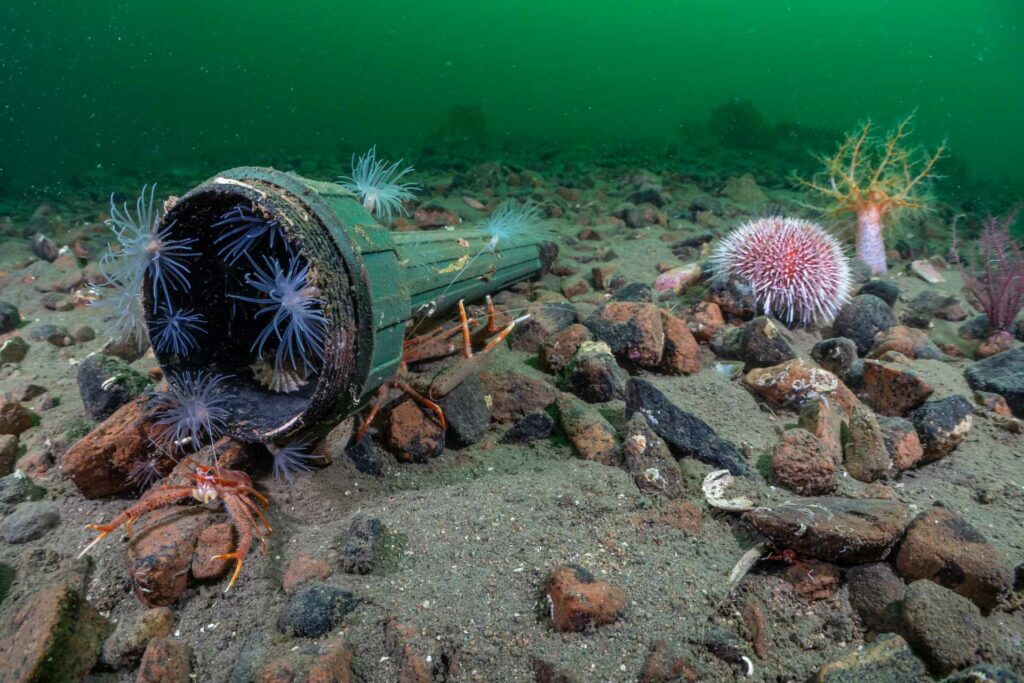
“No matter how much mistreatment our marine life takes, it always has a way of making the most of a bad situation. Here an old diver’s torch has become home to many different species and is becoming part of the environment itself. You can see sea loch anemones on the torch, a couple of small squat lobsters using it as shelter and, in the background, a sea urchin and a sea cucumber complete this pretty reef scene in western Scotland.”
Clingfish, Portland Harbour, by Georgie Bull
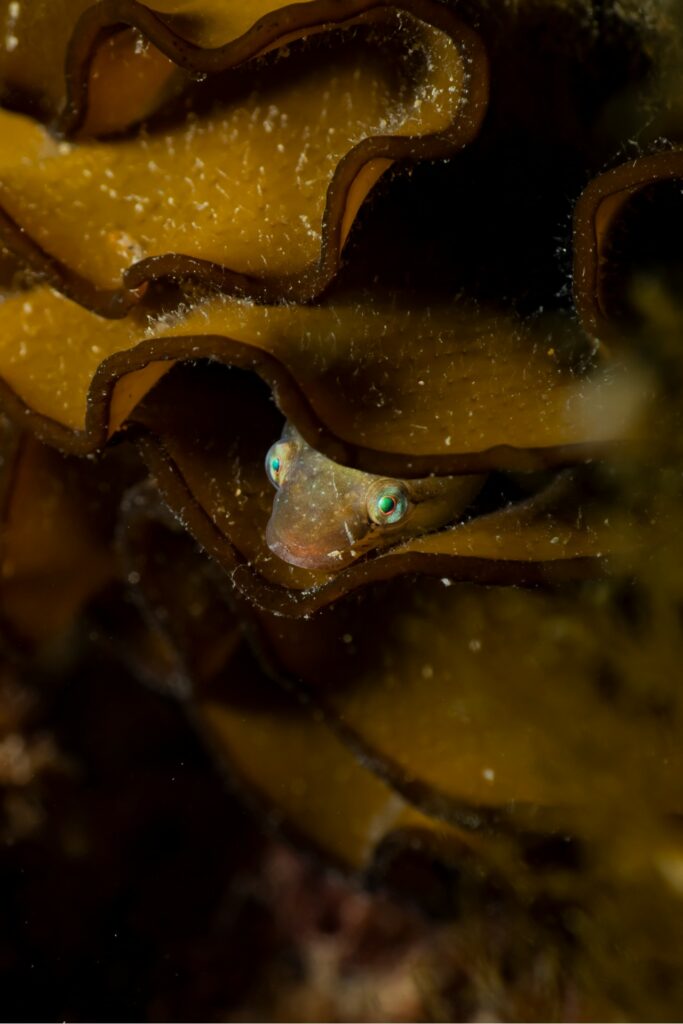
“This image was taken at the end of a dive in Portland Harbour. Just before exiting the water, I decided to check the holdfast (root-like structure) of some wakame kelp attached to a pipe. I’d heard rumours that clingfish lay their eggs in the delicate folds at the base of the stipe but had never been lucky enough to see one with my own eyes.
“To my delight, a pair of eyes stared back at me as I approached. I only had one shot before he retreated into his home, and this was the photo that I took. I really like it because it captures something special about how characterful and charismatic small UK fish are. You just have to know where to look!”
Blue Shark, Penzance, by Jon Bunker
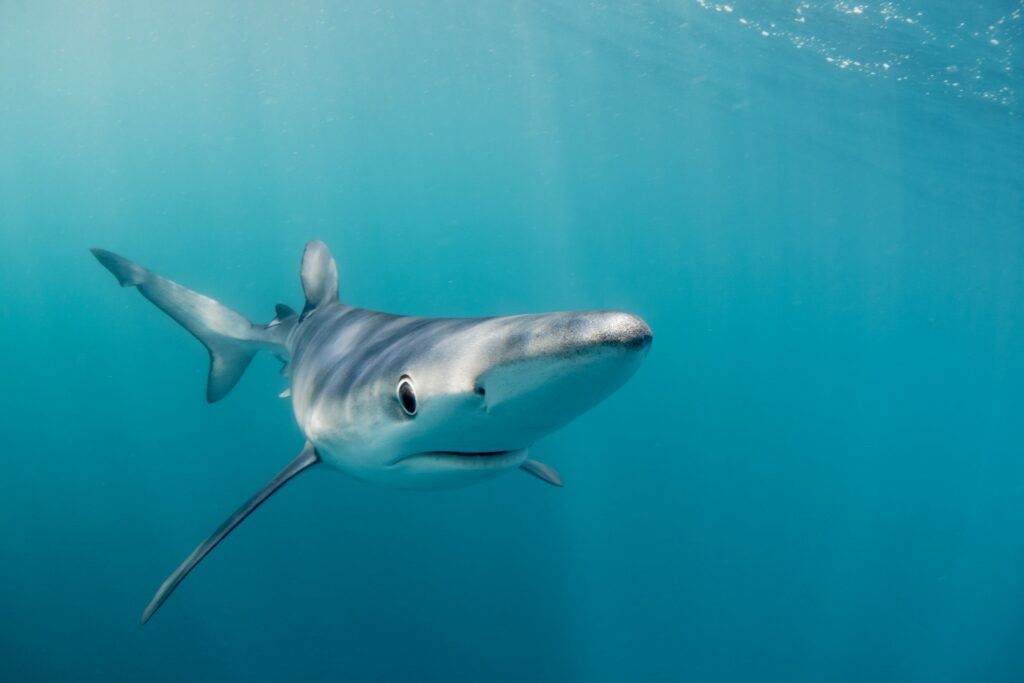
“Perhaps one of our most spectacular summer visitors, the blue shark (Prionace glauca) is a dazzling animal to come across in our seas, shimmering variously indigo, cobalt blue and even bronze in the sunshine. Circulating on a clockwise migratory route with the Gulf Stream, the most typical UK encounters are with younger females like this inquisitive example off Cornwall.
“This elegant creature was most likely looking to fatten up on squid and mackerel over the summer months before journeying back to the tropics. Indeed, it is the wide-ranging pelagic nature of these fish that makes them vulnerable to fishing activity, and they are currently categorised as Near Threatened on the IUCN Red List.”
Northern Gannet, Hermaness National Nature Reserve, Shetland, by Kevin Morgan

“Northern gannets are the largest seabirds in the North Atlantic, with roughly 60-70% of the world’s population choosing to breed in the British Isles. They nest in locations with sufficient updraft to assist them when taking off; the windy stacks and tall cliffs of Shetland are ideal.
“There are an abundance of gannet colonies around Britain and Ireland, with most having been occupied for centuries. Bass Rock is the largest northern gannet colony in the world, home to more than 150,000 birds. The colony featured in this image is at Hermaness National Nature Reserve, which hosts around 30,000 pairs, a spectacular sight to behold as large numbers of birds soar over the stormy waters below.”
Skeleton Shrimp, Pen Wyn Reef, Cornwall, by Kirsty Andrews
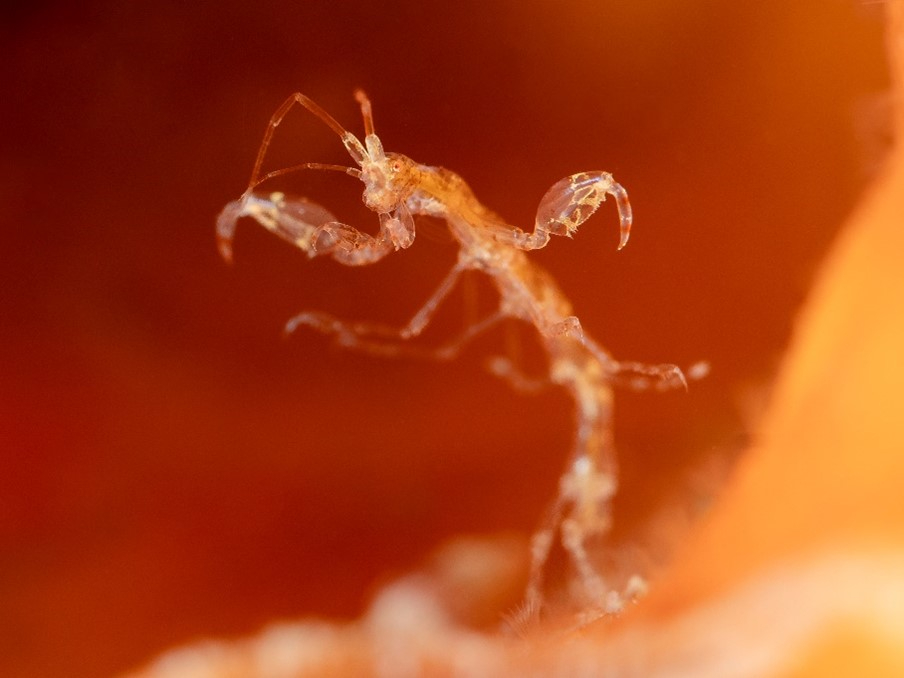
“This image of a skeleton shrimp, or caprellid, was captured on the Manacles reef system. The colourful background is another animal, the orange bryozoan known as ross coral. There were hundreds of skeleton shrimp living on the bryozoan, all only a couple of centimetres in size.
“The young climb all over the bodies of the adults, and the males are noticeably larger than the females. I had to get in close to isolate one individual with my macro lens, to show off the long slender body that gives this animal its ‘skeleton’ name.”
Sea Hare, Silver Steps, Falmouth, by Shannon Moran
(see image at start of feature) “Early in the spring, just before the algae bloom, the waters in Cornwall turn an incredible shade of turquoise. I made the most of the sea conditions and aimed to capture the transition from green algae-filled water to the clear blue shallow water in the background of this image.
“2023 was a bumper year for sea hares at this dive-site, and for a few weeks in the spring the sea floor was absolutely covered with these large sea slugs. This hare was particularly large, at around 20cm!
“It had started to climb up the kelp-covered reef and after a few minutes made its way all the way to the top of this golden kelp stalk, where I captured this image.”
Horse Mussel Bed, Shetland, by Billy Arthur
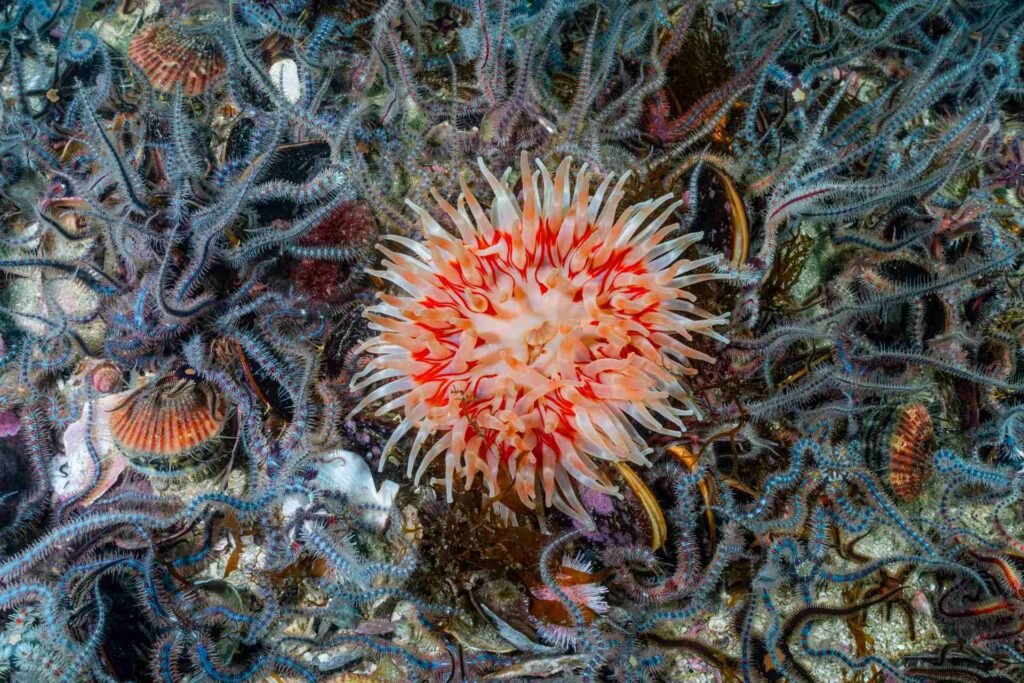
“This horse mussel bed with large dahlia anemone, brittlestars and juvenile queen scallops is situated in a highly tidal site off the east coast of Shetland. It’s a bustling metropolis of marine life! A dense carpet of brittlestars covers the mussel bed and a multitude of other species can be found nestled among the horse mussels.
“If you’re lucky, you might encounter a flapper skate or small-spotted cat shark looking for a meal. The dive-site can be reached only on a slack tide, due to the current being too strong to swim against in full slow. A diverse site with a hint of danger – it doesn’t get much better!”
Tompot Blenny, Torquay, by Jacob Guy
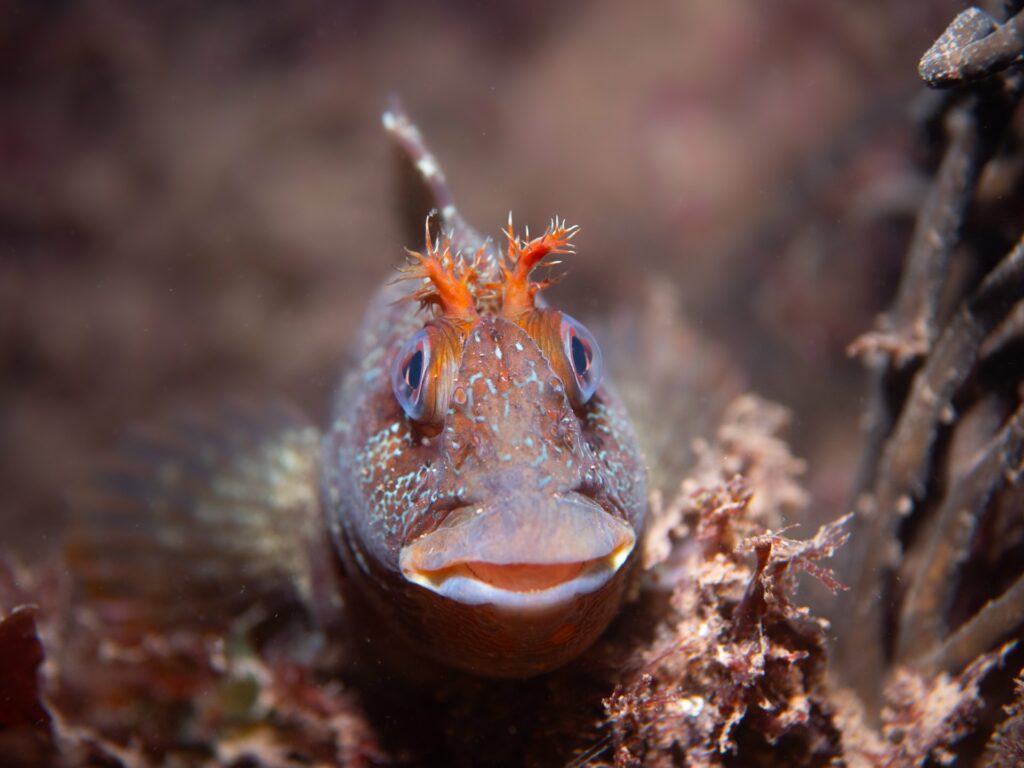
“Tompot blennies are one of the most inquisitive species you find on a dive in the UK, which makes them perfect subjects for photographing. Their amazing patterns and large eyes make them one of my favourite fish species in the world to see on a dive and capture.
“I’d had multiple occasions where these confident blennies would come between me and my camera while shooting other subjects and even sometimes get in the way completely and there’s nothing you can do but smile.”
Jellyfish, by Lewis Jeffries
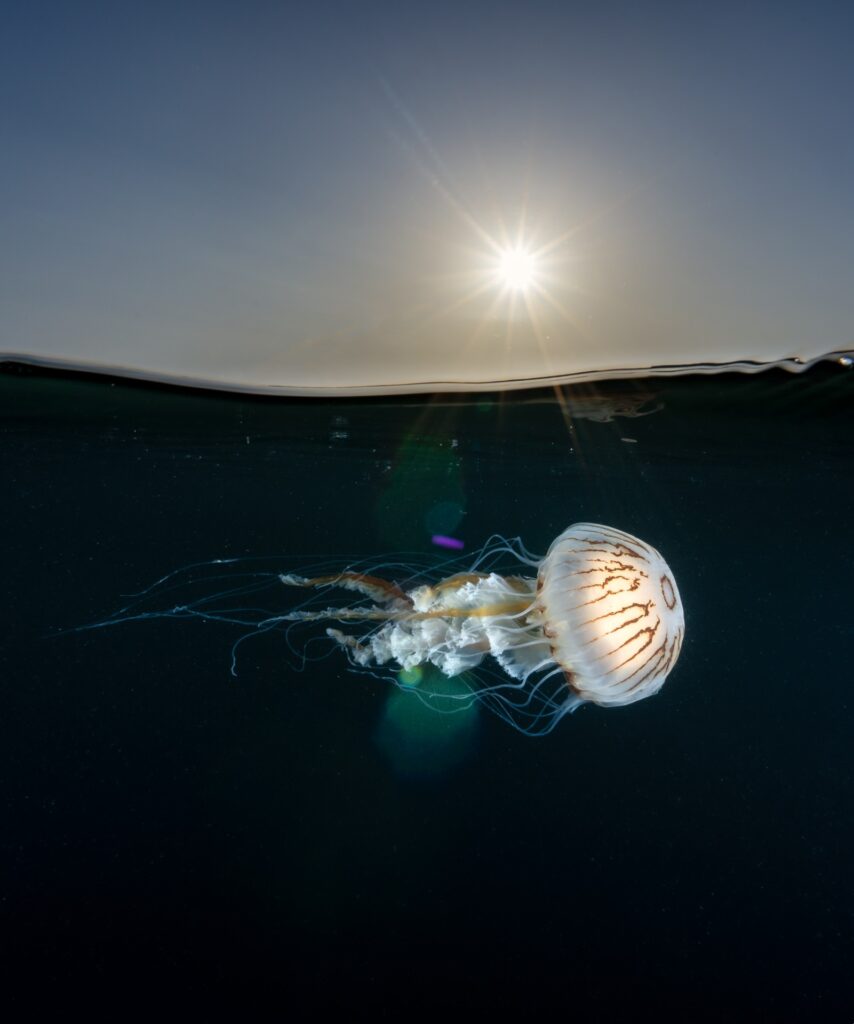
“In the summer months, jellyfish frequent the British Isles in large numbers, thought to be attracted by the warmer waters. This was a perfect summer’s evening – clear and calm, with hardly a breath of wind.
“As the sun dipped lower in the sky the golden hour produced some beautiful light, and I found this individual swimming close to the surface. The golden colours of the jellyfish seemed to match the hue of the sky, making for a pleasing scene.
“I illuminated the jellyfish with flash and the dark background helped the creature stand out, creating a memorable image. I try to capture common subjects in a beautiful way – showing the wonders that are found on our doorstep, in the hope that they can inspire others to appreciate and care for our amazing wildlife.”
Getting involved
The Marine Conservation Society says that people can help safeguard the beautiful diversity of British marine life by getting involved with its work – whether attending a beach clean, making a one-off donation or becoming a member.
Especially for divers and snorkellers, the MCS says that its Seasearch programme is “a great way of giving back and exploring the UK’s waters”. Seasearch volunteers conduct underwater surveys, providing an insight into the state of the seas.
More information about all aspects of the MCS’s work can be found on the charity’s website.
Also on Divernet: Mmm, tastes good – why corals like plastics, Microplastics form vast deep-sea drifts, Ghost-fishing means plastics infest deep coral, Plastics mar hermit-crab home-making, Ocean repels plastics using seagrass balls, Dye exposes ‘invisible’ ocean microplastics

